Rock climbing is a popular sport in the USA that combines physical activity with outdoor adventure. It’s not just about muscle strength; climbers must also think strategically to find the best paths up the rock.
These are the best places for rock climbing in the United States. They are known for their beautiful landscapes and variety of routes, which appeal to both beginners and experienced climbers.
This sport offers great physical benefits, like better strength, flexibility, and endurance. It can also help reduce stress and boost your mood. Whether you are interested in well-known climbing destinations or seeking out hidden gems, the top rock climbing spots in the US offer excellent chances to test your skills and revel in the natural surroundings.
13 Best Places for Rock Climbing in the USA
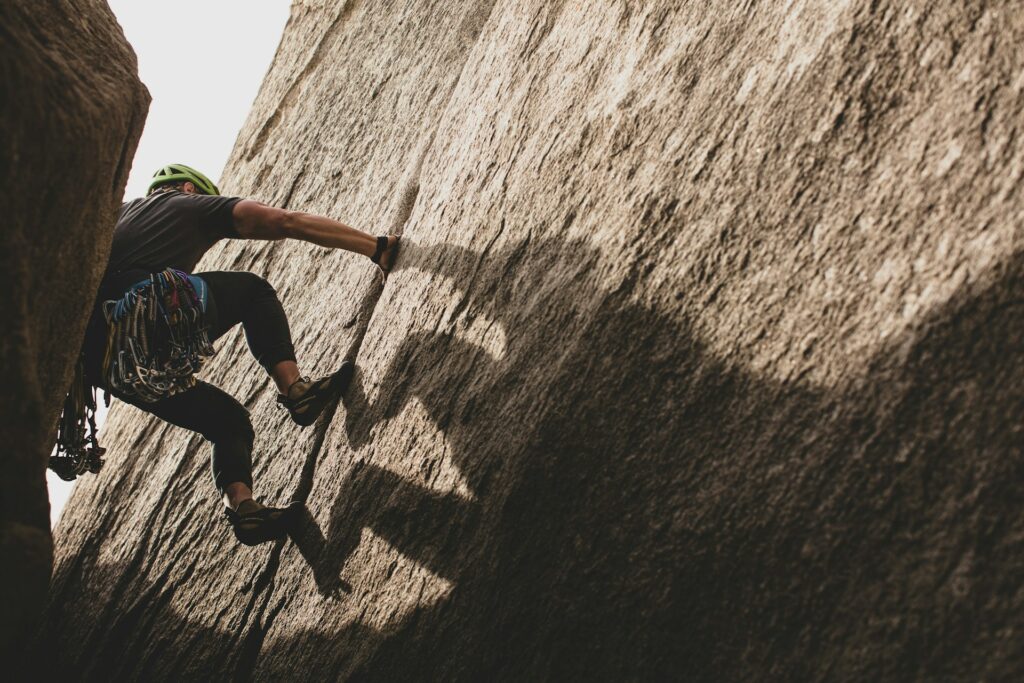
1. Shawangunks (The Gunks), New York
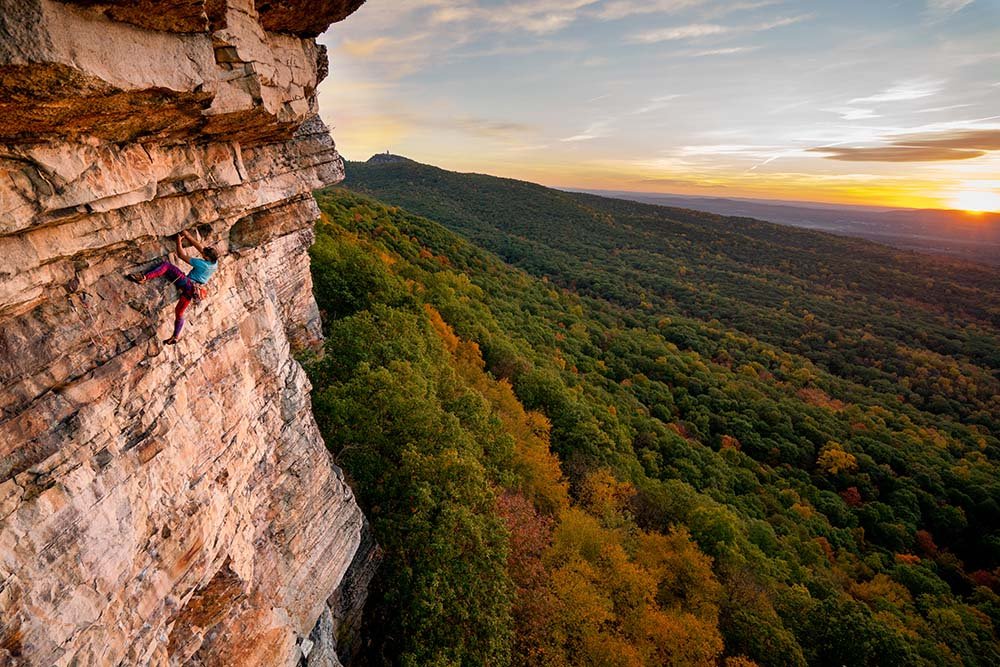
Located less than 90 miles from NYC, the Shawangunks, affectionately known as “The Gunks,” are a premier destination for rock climbing enthusiasts. Known for their durable quartz conglomerate rock, The Gunks offer reliable and varied climbs, including steep exposures and moderate ascents suitable for all skill levels, from grades 5.4 to 5.13a.
This area supports traditional climbing styles and is celebrated for its easy-to-moderate routes, making it one of the best climbing spots in the USA. Year-round climbing, free trip brochures, and guided tour options further enhance the experience for climbers.
Pros
- Proximity to New York City, making it an accessible getaway for those seeking outdoor adventure.
- Professional private guides are available to ensure a safe and enriching climbing experience.
Cons
- Climbing requires a pass, which costs $20 for a day or $95 for a season.
- Some climbing areas may lack sufficient protection, which can be a safety concern.
Best Location For
The Gunks are perfect for climbers who value spectacular views alongside a diverse range of routes. It’s a great spot for newcomers and experienced climbers looking to enjoy scenic climbs close to a major city.
Location and Access
The Gunks are easily accessible from New Paltz, New York, with a straightforward 7-mile drive along Rt. 299 until it intersects with Rt. 44/55.
Availability and Costs
- Half-day of private climbing with a guide: $255.
- Customized full day of climbing: $375.
- Guided rock climbing at Sky Top: $475.
- Transition from gym to crag: $350.
The Shawangunks offer an exceptional climbing experience with their stunning natural beauty and comprehensive range of climbs, making them a top choice for anyone exploring the great outdoors near New York City.
2. Lake Tahoe, Nevada
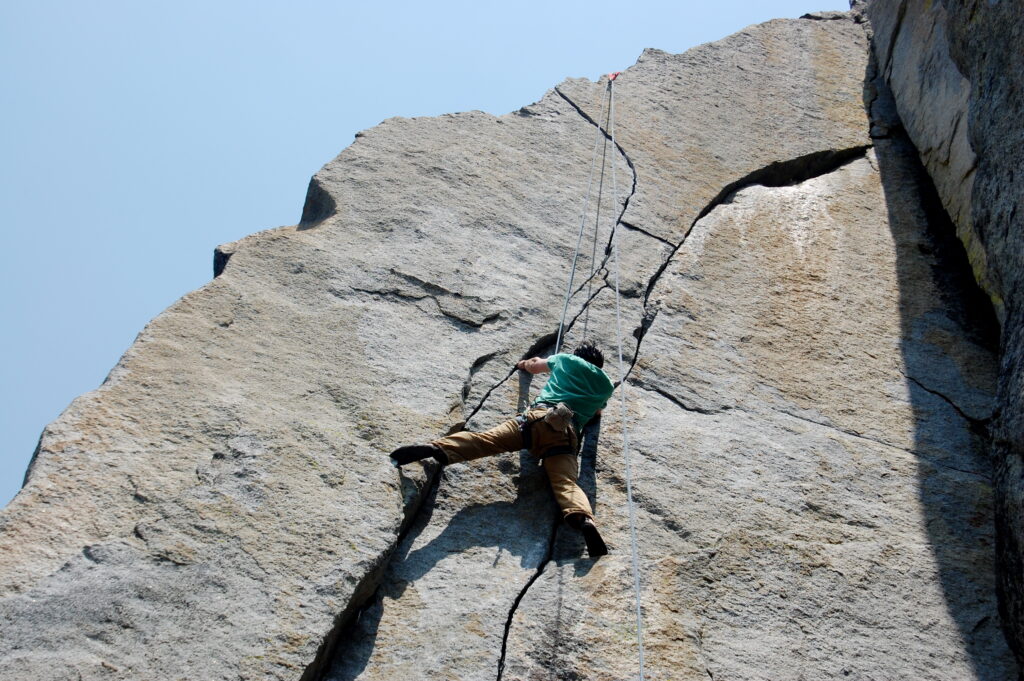
Lake Tahoe is a versatile climbing destination that caters to climbers of all skill levels and preferences. The area is known for its various climbing styles and rock types, offering everything from trad and sport climbing on crags up to grade 5.13 to multi-pitch climbing and bouldering.
Family-friendly and suitable for beginners, Lake Tahoe also provides opportunities for more experienced climbers to challenge themselves. The region is dotted with public lands and offers economical camping options, including aid camping for only $5 per night.
Pros
- It is beginner-friendly yet challenging enough for seasoned climbers.
- Affordable compared to other climbing destinations.
Cons
- The drive to reach the climbing areas can be lengthy and difficult.
- Navigating the paths to the exact climbing spots can be tricky.
Best Location For
Lake Tahoe is ideal for those who enjoy climbing in beautiful, tall locales, particularly for afternoon and sunset sessions. It’s a perfect mix of accessibility and scenic beauty, which helps newcomers have successful and enjoyable climbing experiences.
Location and Access
Located in Nevada, Lake Tahoe is easily accessible from the Reno-Tahoe International Airport, which is about a 45-minute drive from North Lake Tahoe and offers 23 non-stop flights.
Availability and Costs:
- Half-day rock climbing in Lake Tahoe: $425.
- Full-day rock climbing in Lake Tahoe: $550.
- Group rock climbing anchor building course: $250 per day.
Lake Tahoe provides a comprehensive climbing experience with its diverse range of climbing options and stunning natural environment, making it a favored destination for climbers exploring the great outdoors. Whether a short visit or a full-day adventure, Lake Tahoe offers both the thrill of the climb and the peace of the wilderness.
3. Rumney, New Hampshire
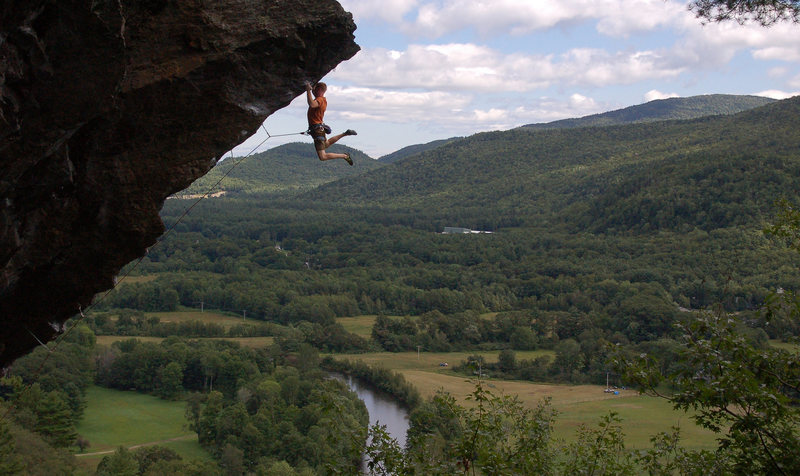
Rumney is celebrated as the finest rock-climbing destination in the Northeast. It boasts a wide array of routes that cater to all levels of climbers, from beginners to experts, with grades ranging from 5.3 to 5.15a.
The area features schist rock that is particularly suited for face climbing and provides a unique experience for sport climbers with its diverse climbing features, such as aretes, corners, and cracks.
Rumney’s well-bolted and protected routes and many shorter climbs make it ideal for those with tight schedules who want a quick but fulfilling climbing experience.
Pros
- Various climbing features, including aretes, corners, and cracks, appeal to diverse climbing preferences.
- Its location in New Hampshire offers easy access and breaks away from the typical climbing locations.
Cons
- The cliff layout can be complex for newcomers, making navigating challenging.
- The abundance of routes might be overwhelming for beginners.
Best Location For
Rumney is a gem for its extensive range of routes, high-quality rock, excellent bolting, and overall accessibility. It’s a favored spot for those who appreciate the breadth and quality of climbing opportunities.
Location and Access
Situated in New Hampshire, Rumney can be reached by taking exit 26 off Interstate 93 in Plymouth, NH, and following Route 25 West.
Availability and Costs
- Half-day of private climbing with a guide: $290.
- Customized full day of private climbing with a guide: $420.
- Private gym to crag transition class: $350.
- Intro to rock climbing class: $350.
- Family rock climbing adventure: $150 per day.
Rumney offers a comprehensive climbing experience with its supportive climbing community, making it an outstanding destination for climbers.
4. Yosemite National Park, California
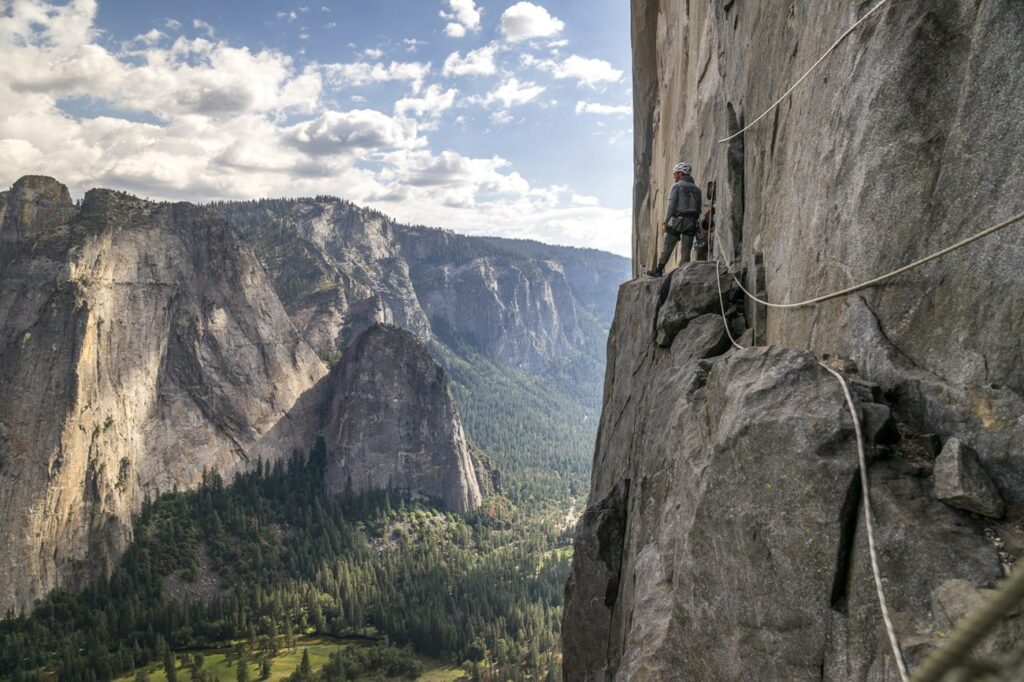
taken from nps.gov
Yosemite National Park is renowned as the historical birthplace of modern rock climbing. The park offers a climbing experience across various terrains, from the verdant valley floor to the rugged highlands of Tuolumne Meadows.
Climbers of all levels can find something to suit their skills, with routes ranging from classic, challenging climbs to newer, more accessible challenges. Approximately 60% of these are traditional climbs, making Yosemite a true haven for purists of the sport. The park is open for climbing year-round, with the awe-inspiring peaks of El Capitan and Cathedral providing iconic challenges that draw climbers worldwide.
Yosemite is also uniquely visitor-friendly; the valley has reliable cell phone coverage and is easily navigable without a vehicle, making it convenient for tourists to explore. These features, combined with the stunning natural scenery and the availability of professional guides through the Yosemite Mountaineering School, create an optimal climbing environment.
Pros
- Excellent communication facilities make it easy to keep in touch while climbing.
- Affordable hiking trails also allow one to explore the park’s natural beauty.
Cons
- The park can get very crowded, especially on weekends, which might affect the climbing experience.
Best Location For
Yosemite is especially famous for its polished granite cliffs, sculpted by glaciation during the Ice Age. These smooth, imposing surfaces offer a unique climbing experience that is physically demanding and visually spectacular.
Location and Access
The park is easily accessible from major cities in California. Visitors can take a bus from various locations and arrive comfortably at Yosemite for a day of climbing.
Availability and Costs
- A 6-hour climbing session costs $270.
- An 8-hour session is priced at $300.
- For those looking to extend their adventure, more than 10 hours are available for $415.
Yosemite merges a rich climbing tradition with comprehensive facilities and breathtaking landscapes. This makes it an ideal destination for climbers who want to test their skills against some of the best routes in the world while immersed in one of nature’s most spectacular settings.
5. Red River Gorge, Kentucky
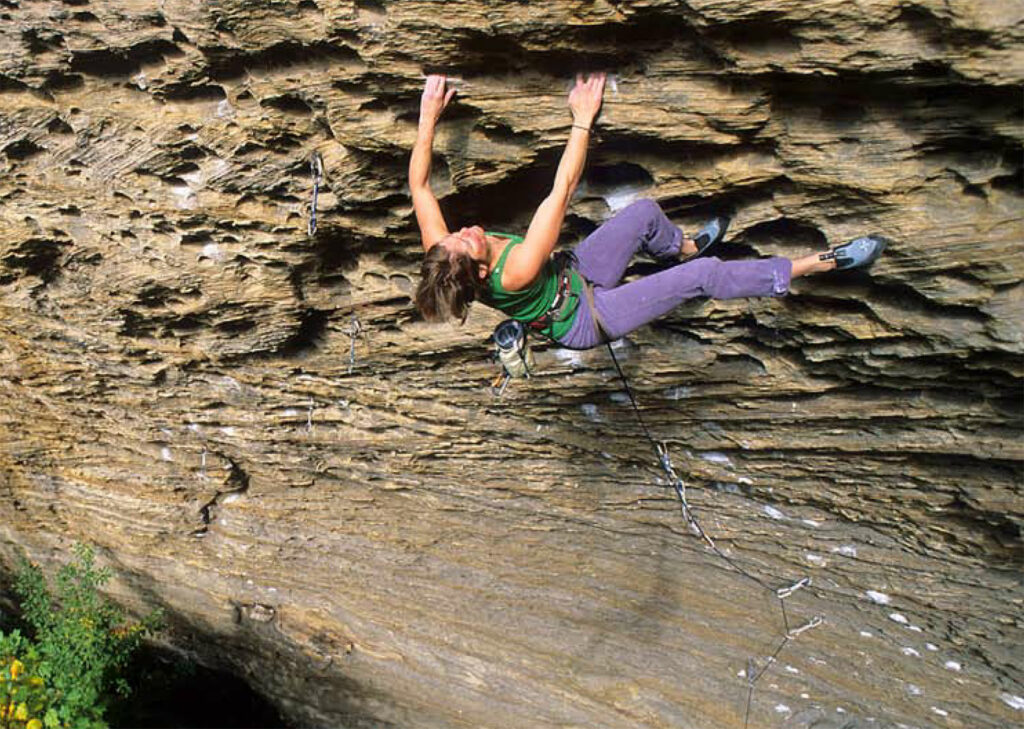
Red River Gorge in Kentucky is a climber’s paradise, offering various climbing experiences from sports to traditional styles.
Known for its Corbin Sandstone rock, this destination caters to all types of climbers. Over 3000 routes span nearly 100 cliffs, featuring grades ranging from 5.4 to 5.14. Even with its popularity, the area is large enough to often provide a sense of solitude.
Many overhanging climbs remain dry even during rain, thanks to the region’s quick-drying steep lines and typically short afternoon storms.
A highlight of the local climbing culture is Miguel’s Pizza, a well-known gathering spot where climbers converge.
Pros
- It features well-bolted, sweeping sports climbs and numerous routes, ideal for a quick half-day trip.
- Affordable access, with a vehicle pass costing only $10.
Cons
- The area can experience high humidity, especially in late spring or early fall.
- Frequent afternoon storms may disrupt climbing plans.
Best Location For
Red River Gorge is renowned for having some of the best single-pitch sports routes in the country, with its chalked-up caves and hollows providing top-notch climbing experiences.
Location and Access
Located about 60 miles southeast of Lexington, Kentucky, in Slade, Red River Gorge is accessible via the Bert T. Combs Mountain Parkway. Take exit 33 for Slade, turn right onto KY 11S, and continue for 30 km to reach the climbing areas.
Availability and Costs
- Half-day of climbing with a private guide: $170.
- Customized full day of climbing with a private guide: $240.
- Intro to the traditional climbing course: $240.
- Gym to crag transition class: $240 per day.
Red River Gorge offers a diverse and engaging climbing experience that appeals to both new climbers and seasoned adventurers, making it a prime destination for those looking to explore the vertical world.
6. Smith Rock State Park, Oregon
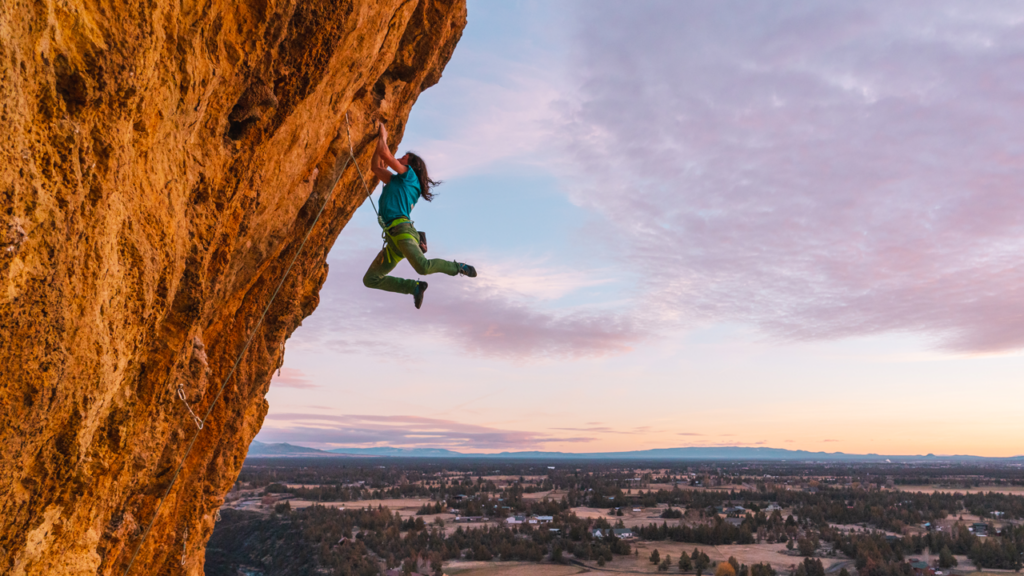
Smith Rock State Park in Oregon is celebrated as the birthplace of American sport climbing and offers easy access to a wide range of climbing experiences.
Smith Rock State Park features well-maintained trails and bridges that lead directly to the crags, facilitating both sport and trad climbing in single and multi-pitch formats. Conveniently located campgrounds next to climbing areas make it an attractive destination for visitors looking to spend multiple days.
With over 1,500 climbing routes on just 650 acres, climbers can enjoy a variety of styles and difficulties, making Smith Rock a comprehensive climbing destination.
Pros
- Set against the stunning backdrop of the Cascade Range volcanoes.
- Features popular climbing spots such as the Liama Wall, offering memorable climbs.
Cons
- The park tends to be crowded, attracting both climbers and hikers.
- Parking can be challenging due to the high visitor volume.
Best Location For
Smith Rock State Park is ideal for those who love climbing options. With sunny weather and a compact area packed with routes, it offers an intensive climbing experience that caters to all levels of climbers.
Location and Access
Located in Oregon, Smith Rock State Park is accessible via US-97. Turn east onto Smith Rock Way in Terrebonne and continue for three miles to Lambert Road, which leads directly to the park.
Availability and Costs
- Half-day of private climbing with a guide: $275.
- Full-day of private climbing with a guide: $350.
- Classic cracks climb $400.
- Climbing the Titan with a guide: $700.
Smith Rock State Park offers a wide array of climbing routes and a picturesque setting that enhances the climbing experience. Whether you’re new to climbing or an experienced climber, the park’s diverse routes and beautiful landscape make it a must-visit destination.
7. Red Rock, Nevada
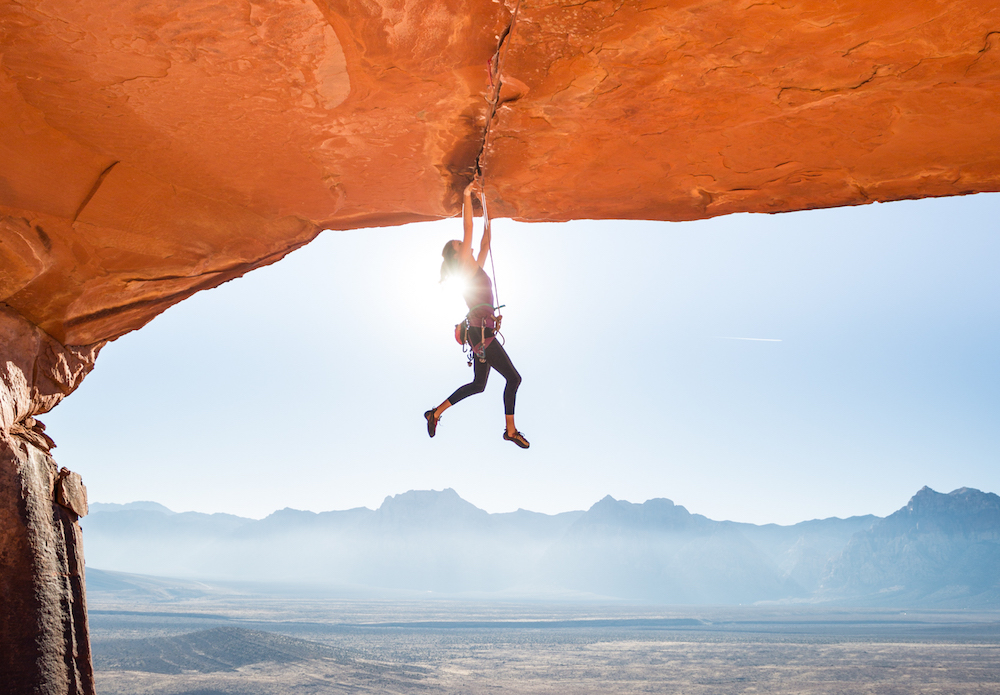
Red Rock in Nevada is a premier climbing destination known for its versatility and extensive climbing season, one of the longest in the US.
This area offers a broad spectrum of climbing styles, from limestone and sandstone to traditional and sports climbing, catering to beginners and experienced climbers.
Its proximity to Las Vegas enhances accessibility and provides additional amenities such as hotels and quick routes to the crags.
With its intuitive patina and formations, the stunning Aztec Sandstone presents climbers with routes ranging from 5.7 to 5.12, all set against breathtaking scenic backdrops.
Pros
- Varied climbing options, including single-pitch routes and formidable vertical walls.
- Conveniently located hotels allow climbers to transition from their rooms to the crags in just half an hour.
Cons
- Limited camping facilities.
- The scenic loop drive required to access some crags adds extra logistics.
Best Location For
Red Rock is especially suited for those looking to explore long-term climbing on Aztec Sandstone, which provides excellent conditions for a wide range of climbing techniques.
Location and Access
Red Rock Canyon is about 25 miles west of the Las Vegas Strip. Access is straightforward via Charleston Boulevard from the Strip and Downtown Las Vegas, which turns into SR 159, or from the south via Blue Diamond Rd/SR 160 west to the junction with Route 159.
Availability and Costs
- Half a day of private climbing with a guide: $280.
- Full day of climbing with a guide: $390.
- Level 1 multi-pitch rock climbing: $410 per day.
- Level 2 multi-pitch rock climbing: $475 per day.
- Level 3 multi-pitch rock climbing: $600 per day.
Red Rock offers a unique blend of climbing experiences in a highly accessible location, making it a favorite among climbers who enjoy a mix of scenic beauty and diverse climbing routes close to urban conveniences.
Looking for a challenging multi-pitch adventure or a more relaxed single-pitch day, Red Rock provides an array of options to suit any climber’s needs.
8. Indian Creek, Utah
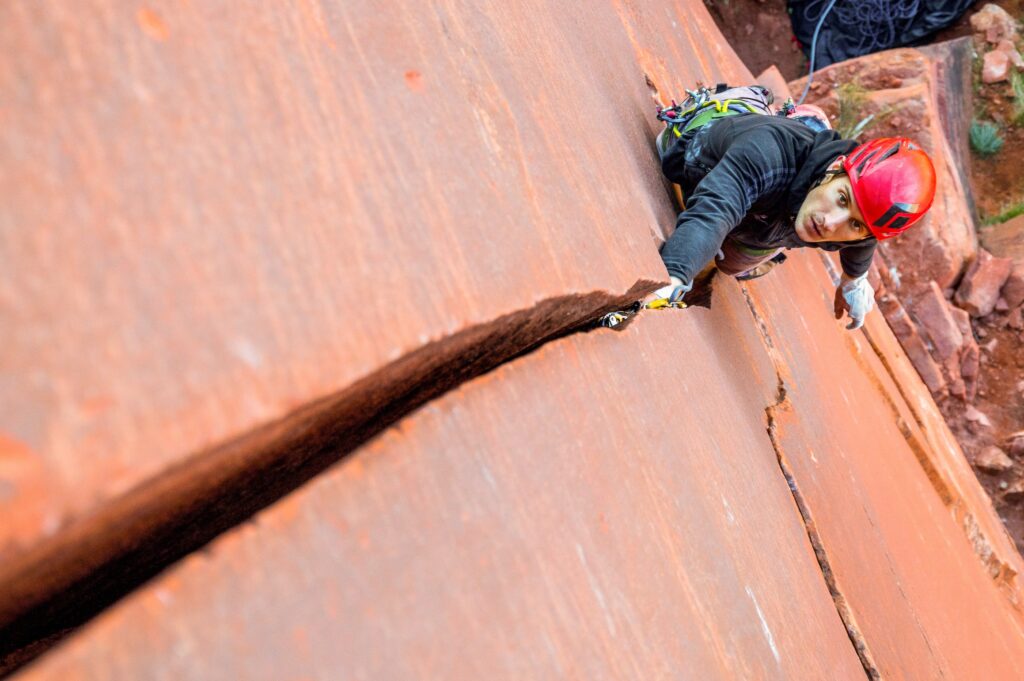
Indian Creek in Utah is a renowned climbing destination. It is famous for its spectacular Wingate Sandstone rock formations, which offer perfect splitter cracks ideal for traditional climbing. This location allows for climbing throughout most of the year, thanks to its mix of sunny and shaded areas.
Its proximity to Canyonlands National Park, Moab, and Monticello also means climbers can enjoy various activities on rest days.
The rock formations here feature long, consistently sized, parallel-sided cracks that appeal to climbers of all skill levels. Indian Creek fosters a strong community spirit, with climbers often setting up ropes and sharing climbs.
Pros
- Offers specialized climbing retreats for women alongside general sessions.
- Adheres to COVID-19 safety measures to ensure the well-being of all participants.
- Suitable for beginners due to the nature of the climbing routes.
Cons
- Lacks cell phone coverage, which can be a challenge for staying connected.
- Requires a 70 m rope for most climbs due to the length and nature of the routes.
Best Location For
Indian Creek is best known as a vast and pure climbing site, predominantly for crack climbing. Its expansive and uniform cracks make it a favorite among traditional climbing enthusiasts.
Location and Access
In Utah, Indian Creek is accessible via the last station on the Blue Line at Indian Creek. The bus loop is off Elder Lane, with large surface lots offering free daily parking.
Availability and Costs
- Whole-day rock climbing: $425.
- 3-Day Indian Creek crack climbing experience: $1485 per person.
- Women’s crack climbing retreat: $1345 per day.
Indian Creek provides a unique and immersive climbing experience with its iconic cracks and beautiful desert setting, complemented by a vibrant climbing culture and community-oriented atmosphere. Improve your skills or be an experienced climber seeking challenging routes, Indian Creek offers an unforgettable adventure.
9. Joshua Tree National Park, California
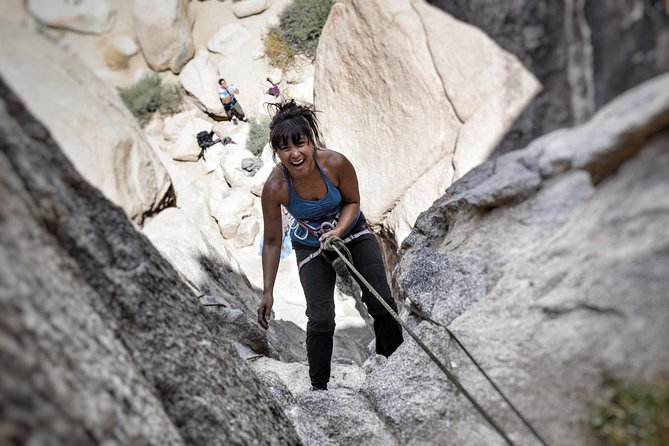
Joshua Tree National Park is a favored climbing destination for its accessibility and unique desert environment. Home to over 8,000 routes, this park accommodates all skill levels with various terrains and the quartz Monzonite rock type, known for its grippy surface.
The park’s layout practically steps out of their cars and onto the rocks, with campgrounds conveniently located near climbing sites.
Joshua Tree is also an excellent place for learning safety skills and self-rescue techniques, thanks to the nature of its routes.
Pros
- Plenty of shade is available for comfortable climbing.
- Shorter routes make climbing accessible and less intimidating.
Cons
- Walk-offs for classic routes can be more daunting than the climbs themselves.
- Some routes may be challenging for inexperienced climbers.
Best Location For
The park is in the Lost Horse Valley, known for its smaller grain size and dense concentration of formations. This area is ideal for newcomers or those unfamiliar with Joshua Tree’s climbing environment.
Location and Access
Joshua Tree can be located in California via Interstate 10 or California Highway 62 (Twentynine Palms Highway). The nearest airport is Palm Springs, making it easily accessible for local and international climbers.
Availability and Costs:
- Half-day of private climbing with a guide: $320.
- A full day of private climbing with a guide: $455.
- Gym to Crag 101 course: $100 per day.
- Gym to Crag anchor building: $120 per day.
Joshua Tree offers a distinctive climbing experience in a picturesque desert setting, making it a prime choice for climbers who value easy access and a variety of challenges. Joshua Tree provides the perfect backdrop for refining your climbing skills or enjoying a day of adventure.
10. New River Gorge, West Virginia
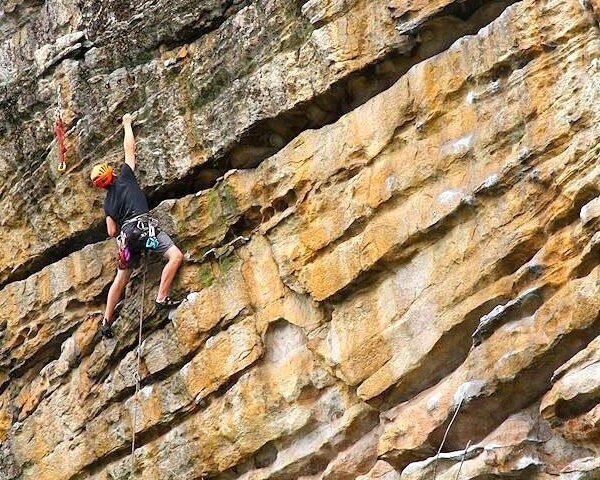
New River Gorge in West Virginia is renowned for its extensive climbing offerings, with nearly equal opportunities for sport and traditional climbing. This destination features a rock type that allows for climbing even in wet conditions, making it a reliable year-round spot.
It is close to town and provides easy access to thousands of climbing routes and an extensive boulder concentration in the mid-Atlantic region. The park’s vast cliff lines and short approaches to drop-top loops make it a favorite among climbers of all skill levels.
Pros
- Generally not crowded, offering a more secluded climbing experience.
- Good communication coverage throughout the area.
Cons
- Access to some cliffs may require navigating ladders, which can be challenging.
- The climbing can be too advanced for beginners.
Best Location For
New River Gorge is ideal for those looking for a diverse and long-term climbing experience, with enough routes to keep enthusiasts engaged indefinitely.
Location and Access
Located in West Virginia, New River Gorge is easily accessible from interstates 64, 77, and 79, as well as from U.S. Route 60 (Midland Trail Scenic Highway), placing it within reach of America’s newest national park.
Availability and Costs
- Half-day of private climbing with a guide: $265.
- Customized full day of climbing with a guide: $370 per day.
New River Gorge offers a unique blend of accessibility, a vast array of climbing routes, and beautiful natural settings, making it a top destination for climbers seeking a comprehensive and challenging outdoor experience.
11. Moab, Utah
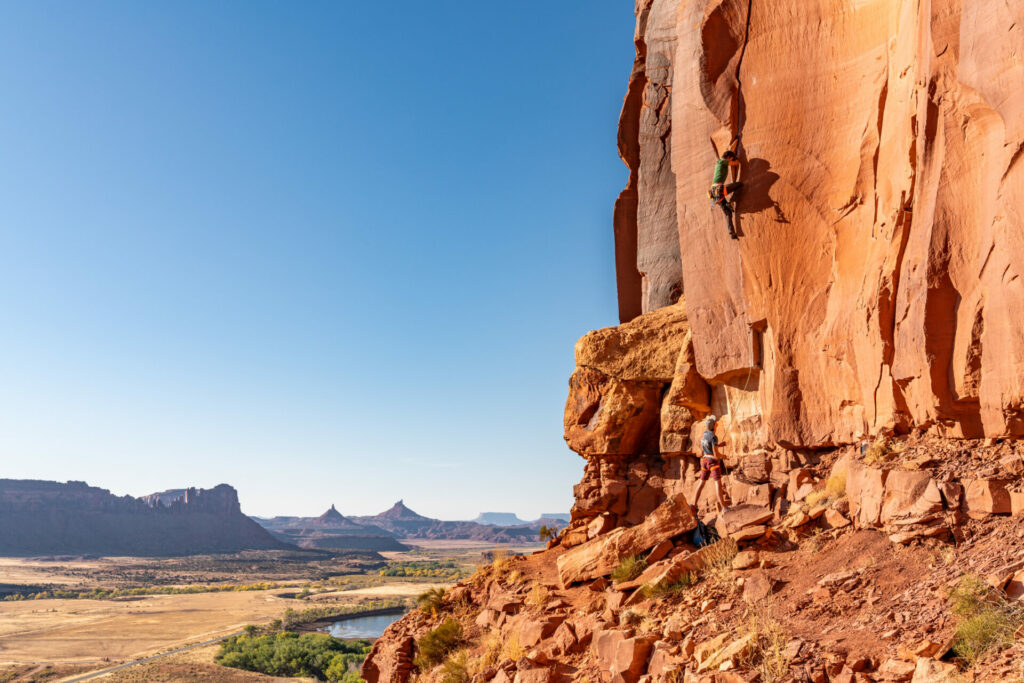
Moab is celebrated as a world-class destination for rock climbing, offering a vast array of routes that cater to all levels of climbers. From sports climbing and traditional routes to bouldering, the area is renowned for its varied climbing experiences, including the iconic splitter cracks and majestic towers.
Moab’s diverse elevations allow for climbing in most months of the year, and its proximity to national parks like Arches and Canyonlands enhances its appeal, offering endless opportunities for exploration.
Pros
- Rest day activities are available, making it ideal for prolonged stays.
- The climbing is accessible for climbers of all types, from beginners to advanced.
Cons
- Moab’s small-town infrastructure can struggle with traffic, especially during peak tourist seasons.
- The nearest major airport is four hours away, making access somewhat challenging.
Best Location For
Moab is a premier spot for splitter crack climbing, providing some of the best formations for this style globally. It’s also perfect for gym climbers eager to experience outdoor climbing in a spectacular setting.
Location and Access
Moab is located in Utah and accessible via the Canyonlands Field Airport, just 18 miles north of town. Salt Lake City provides a major airport option, although it’s a four-hour drive from Moab.
Availability and Costs
- Half-day of private climbing with a guide: $275.
- Full-day of private climbing with a guide: $350.
- Classic cracks climbing session: $400.
- Climbing the Titan with a guide: $700 per day.
Moab’s unique combination of scenic beauty, extensive climbing options, and nearby national parks make it an exceptional choice for climbers looking to blend outdoor adventure with breathtaking natural surroundings.
12. Hueco Tanks State Historic Site, Texas
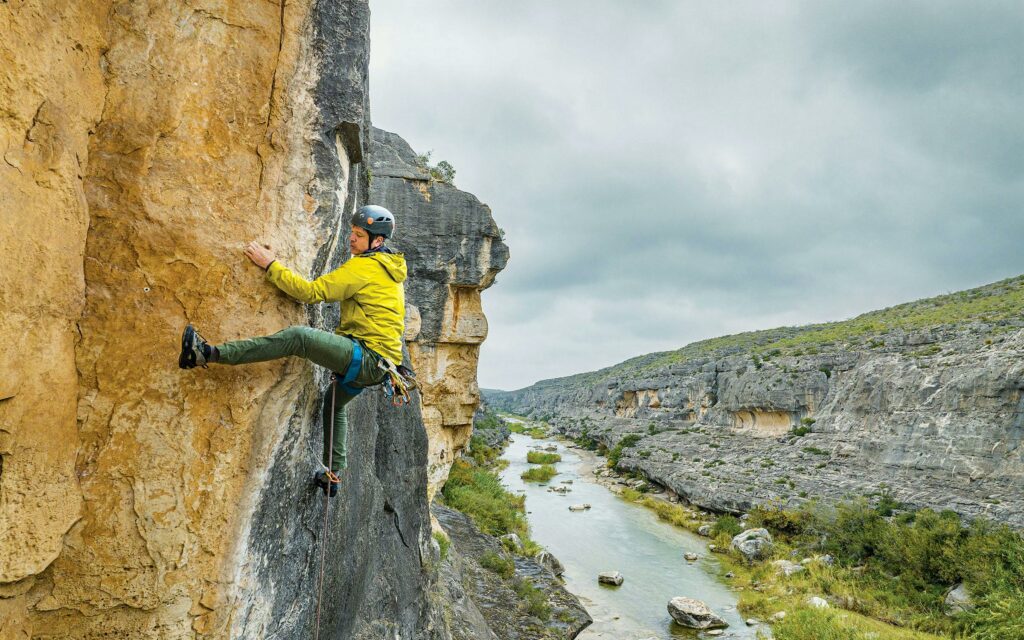
Hueco Tanks State Historic Site, located near El Paso, Texas, is globally recognized as one of the top bouldering destinations.
The site features diverse bouldering challenges, including roof climbs, highballs, and crimps, set against a backdrop of natural rock basins that collect rainwater.
In addition to climbing, visitors can hike, watch birds, and explore ancient pictographs and petroglyphs. The park offers guided and self-guided tours, and its camping facilities are enhanced by its rich historical context and natural beauty.
Pros
- Ample parking and well-equipped campsites enhance the visitor experience.
- A variety of rest day activities are available, catering to different interests.
Cons
- Climbing activities are tightly regulated to protect the site’s natural and cultural resources.
- Hueco Tanks is primarily a day-use park, which may limit the time visitors can spend exploring.
Best Location For
This site is ideal for those looking to combine outdoor activities like picnicking, camping, and climbing with cultural and historical exploration.
Location and Access
Hueco Tanks is at 6900 Hueco Tanks Road No. 1, El Paso, TX 79938, USA. This makes it easily accessible for travelers from within Texas or neighboring states.
Hueco Tanks offers exceptional bouldering, a chance to connect with ancient histories, and various natural activities, making it a comprehensive destination for outdoor enthusiasts.
13. Pace Bend Park, Texas
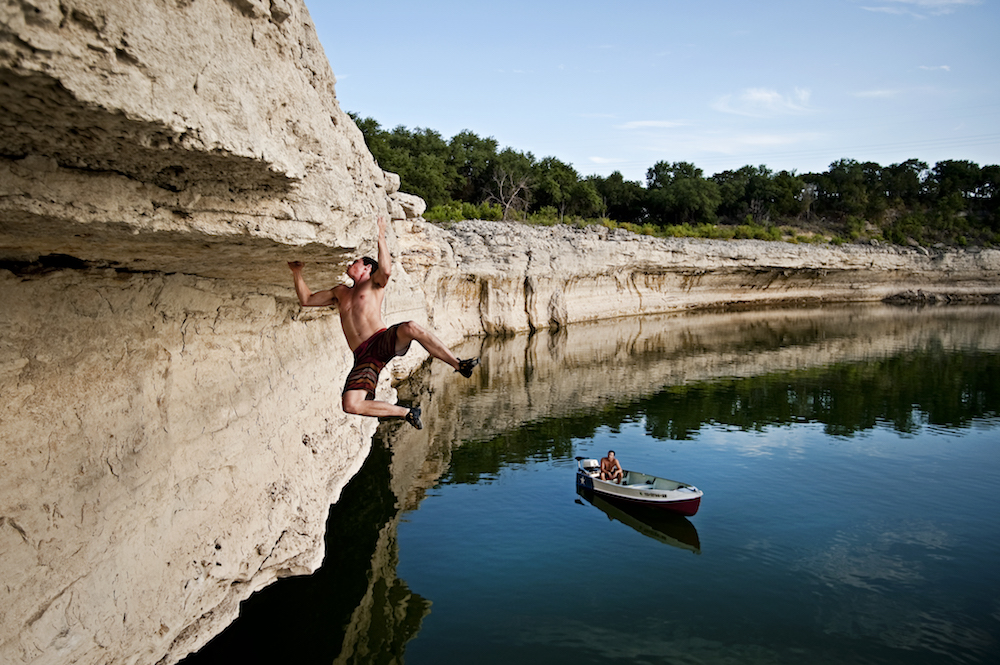
Pace Bend Park, situated near Lake Travis in Texas, is ideal for those looking for various outdoor adventures, including rock climbing, camping, and water sports. The park is known for its accessible climbing options with plenty of shorter cliffs, perfect for free solo water climbing and cliff jumping.
Primitive camping sites offer a rustic experience, and the park’s natural overhanging caves add to its scenic beauty. Due to the favorable rock textures, climbers can enjoy barefoot ascents, making it a great location for beginners or those looking for a quick climb during a busy schedule.
Pros
- Sufficient camping facilities provide a comfortable stay for visitors.
- The park’s proximity and layout allow for flexible visits, accommodating those with tight schedules.
Cons
- Parking is limited, which can be a challenge during peak times.
- The area lacks adequate protective measures for climbing, which could be a safety concern.
Best Location For
Pace Bend Park is best known for its thrilling camping experiences on cliffs overlooking Lake Travis. It’s also a popular destination for swimming, boating, and hiking, providing a comprehensive outdoor recreational area.
Location and Access
The park is at 2805 Pace Bend Road North, Spicewood, TX 78669. This location is easily accessible from major roads, making it a convenient getaway for day trips or longer camping excursions.
Pace Bend Park offers a unique blend of climbing and water sports set against the backdrop of Lake Travis. Its minimal gear requirements and easy climbs make it an inviting destination for climbers of all skill levels, while the primitive camping and natural beauty appeal to those looking to escape into nature.
Conclusion
The many rock climbing spots across the United States, like Yosemite, Moab, and the Red River Gorge, are more than just places to practice the sport—they’re gateways to the great outdoors. Each site has unique rocks and history, offering something special for beginners and expert climbers.


